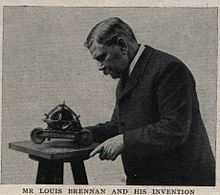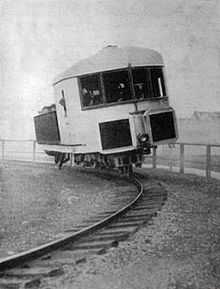Louis Brennan
| Louis Brennan CB | |
|---|---|
 Louis Brennan with a demonstration model | |
| Born |
28 January 1852 Castlebar, Ireland |
| Died |
17 January 1932 (aged 79) Montreux, Switzerland |
Cause of death | Motor vehicle accident |
Resting place |
St. Mary's Roman Catholic Cemetery, Kensal Green, London 51°31′47″N 0°13′44″W / 51.529679°N 0.228953°W |
| Nationality | Irish-Australian |
| Occupation | Mechanical engineer and inventor |
| Known for | Inventor of the steerable Brennan Torpedo |
Louis Brennan CB (28 January 1852 – 17 January 1932) was an Irish-Australian mechanical engineer and inventor.
Biography
Brennan was born in Castlebar, Ireland, and moved to Melbourne, Australia in 1861 with parents. He started his career as a watchmaker and a few years later was articled to Alexander Kennedy Smith, a renowned civil and mechanical engineer of the period.
Brennan invented the idea of a steerable torpedo in 1874, from observing that if a thread is pulled on a reel at an angle with suitable leverage, the reel will move away from the thread side. Brennan spent some years working out his invention, and received a grant of £700 from the Victorian government towards his expenses. He patented the Brennan Torpedo in 1877. The idea was trialled at Camden Fort near Crosshaven, Cork, Ireland.[1]
Brennan went to England in 1880 and brought his invention before the War Office. Sir Andrew Clarke alerted the authorities to the possibilities of the torpedo if used in the defence of harbours and channels, and the patent was eventually bought for a sum believed to be more than £100,000. In 1887 Brennan was appointed superintendent of the Brennan torpedo factory, and was consulting engineer 1896–1907.
He did much work on a monorail locomotive which was kept upright by a gyrostat. In 1903 he patented a gyroscopically-balanced monorail system that he designed for military use; he successfully demonstrated the system on 10 November 1909, at Gillingham, England, but fears that the gyroscopes might fail prevented adoption of the system for widespread use.[2]
From 1916 to 1919 Brennan served in the munitions inventions department. From 1919 to 1926 he was engaged by the air ministry in aircraft research work at the Royal Aircraft Establishment, Farnborough,[3] and gave much time to the invention of a helicopter. The government spent a large sum of money on it, but in 1926 the air ministry gave up working on it, much to Brennan's disappointment.[4]

In January 1932 he was knocked down by a car at Montreux, Switzerland, and died on 17 January 1932. He had married Anna Quinn (died 1931) on 10 September 1892. He was survived by a son and a daughter. Brennan was created a Companion of the Order of the Bath in 1892, and was foundation member of the National Academy of Ireland in 1922.[3]
Brennan was buried at St. Mary's Roman Catholic Cemetery, Kensal Green, London, in an unmarked plot numbered 2454 that is opposite the Chapel record office.[5]
Gillingham Library retains the archive of his papers.
See also
- Gillingham
References
- ↑ McGrath, Walter (1986). Journal of the Irish Railway Records Society 16 (100): 82–86.
- ↑ "Monorails in History: Part I". The Monorail Society. Retrieved 8 November 2005.
- ↑ 3.0 3.1 Sandow, Mary (1969). "Brennan, Louis (1852 - 1932)". Australian Dictionary of Biography, Volume 3. Melbourne University Press. pp. 223–224. Retrieved 22 February 2008.
- ↑ Serle, Percival (1949). "Brennan, Loius". Dictionary of Australian Biography. Sydney: Angus and Robertson.
- ↑ "Persons of Note". Burial records. London: St Mary's Cemetery, Kensal Green. March 2000. Retrieved 6 April 2012.
Further reading
- Tomlinson, Norman (1980). Louis Brennan: Inventor Extraordinaire. John Halliwell. ISBN 0905540182.
- Wilkes, Robert Edward (1973). Louis Brennan CB. Gillingham Library & Arts Committee. p. 30. ISBN 0903316056.
External links
- The gyroscopic monorail of Louis Brennan
- "Louis Brennan: The Wizard of Oz" in Heroes and Villains of Ireland. Turtle Bunbury.